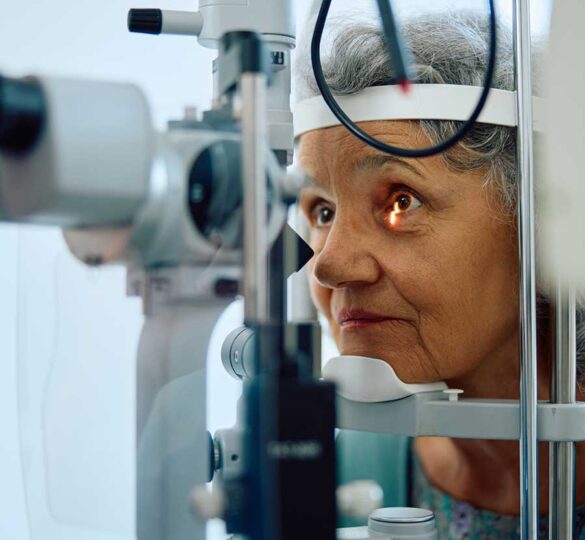Glaucoma Treatments and Management
The field of glaucoma research has introduced many innovative new treatments over the past several years — from minimally invasive glaucoma surgeries to new drug delivery devices.

Recent advancements in glaucoma care — from minimally invasive glaucoma surgeries to subconjunctival microshunts and new drug delivery devices — have considerably increased treatment options.
In this way, clinicians are better able to adapt treatment to each patient’s lifestyle.
As research advances and knowledge about glaucoma continue to grow, there are more treatment options than ever before. In some cases, glaucoma can be treated with eye drops.
Further options now and in the future include extended drug delivery methods, laser treatment, less invasive surgical techniques, and traditional surgery to lower eye pressure.
Eye Drops
Using glaucoma eye drops — All glaucoma eye drops must be used as directed. If the eye drops are uncomfortable or inconvenient, patients should never discontinue them without consulting their eye doctor about possible alternative glaucoma treatments. Failing to comply with your glaucoma treatment regimen increases your risk of vision loss from glaucoma.
Newer Medications
Rhopressa and Rocklatan
A novel rho-kinase inhibitor called Rhopressa® (netarsudil), FDA approved in 2018, reduces IOP by increasing aqueous fluid drainage from the eye via its main drainage pathway, the trabecular meshwork. Rhopressa is prescribed for once-a-day use.
In addition, a rho-kinase inhibitor/prostaglandin combination intraocular pressure (IOP) lowering eye drop, Rocklatan®, is also now available. The combination of netarsudil and latanoprost uses a dual mechanism of action to enhance IOP outflow. A one-year trial of netarsudil-latanoprost versus its separate components showed that the combination eye drop achieved lower IOP at all time points.
Vyzulta®
This dual-mechanism eye drop, FDA approved in 2017, is an enhancement of latanoprost which releases nitric oxide to relax the trabecular meshwork. The VOYAGER trial demonstrated a superior effect compared with latanoprost. A recent trial showed it to be more effective than latanoprost.
Conventional Eye Drops
Prostaglandins increase the outflow of aqueous fluid from the eye through its alternate route, the uveoscleral pathway. These are typically used once daily. Brand names (and generic names) include: Lumigan® (bimatoprost); Travatan Z ® (travoprost); Xalatan® (latanoprost); and Zioptan® (tafluprost).
Beta-blockers slow the production of aqueous fluid in your eye to reduce eye pressure. Examples include Betoptic® (betaxolol) and Timoptic® (timolol). Beta-blockers may be prescribed for use once or twice daily.
Carbonic anhydrase inhibitors reduce the production of fluid in the eye. Examples include Azopt® (brinzolamide) and Trusopt® (dorzolamide). Carbonic anhydrase inhibitors usually are prescribed for use two to three times a day.
Alpha-adrenergic agonists can both reduce aqueous production and increase aqueous drainage. Examples include Alphagan P® (brimonidine) and Iopidine® (apraclonidine). Alpha-adrenergic agonists may be prescribed for use twice or three times a day.
Combination drops including Rocklatan (see above) and Cosopt® (dorzolamide/timolol), Combigan® (brimonidine/timolol), and Simbrinza® (brimonidine/brinzolamide) may allow great pressure reduction than either component with a reduced number of drops.
Preservative-free options may help patients with toxicity or allergy to preservatives and include Zioptan® (tafluprost) and PF Cosopt.
Other medications used less commonly at present include oral carbonic anhydrase inhibitors, such as Diamox® (acetazolamide) and Neptazane® (methazolamide). These medications may be helpful in some situations but carry the risk of other side effects throughout the body. In addition, pilocarpine is less commonly used now because of discomfort and blurred vision and the need for more frequent dosing in some cases.
Laser Treatment
There are two main types of laser to treat glaucoma, depending on the type of glaucoma present. These procedures are usually done in the ophthalmologist’s office or an outpatient surgery center.
Selective Laser Trabeculoplasty (SLT) is a form of laser treatment that lowers the pressure and helps glaucoma patients by applying laser energy to the eye’s drainage tissue, starting a chemical and biological change in the tissue that can lead to better fluid drainage out of the eye.
It’s called “Selective” because the laser selectively affects the pigmented tissue in the eye without causing collateral damage to other parts of the tissue. This advantage makes SLT repeatable in the proper setting.
Though traditionally used as an alternative or supplement to medication, SLT is quickly becoming more accepted as a first-line treatment. From the Glaucoma Laser Trial in 1995 to the more recent LiGHT clinical trial, large clinical studies have shown initial laser for open-angle glaucoma to be equivalent or even superior to medications.
A laser iridotomy may be a preventative step for patients with anatomically narrow angles or treatment for angle-closure glaucoma. A laser iridotomy creates a small opening in the iris to free fluid trapped behind the iris, pushing it forward and potentially closing the drainage angle. The procedure is used when it’s determined that the benefits (treatment or prevention of glaucoma) outweigh the rare but possible risks (bleeding, glare, pain, worsening of condition).
Minimally Invasive Glaucoma Surgery (MIGS)
Minimally (or Micro-) Invasive Glaucoma Surgery (MIGS) has been available for several years and offers a safer option to reduce eye pressure than conventional surgery, typically with a faster recovery time. Because of their lower risk, MIGS procedures may be considered for patients with mild to moderate glaucoma, sometimes as an adjunct to cataract surgery. A recently released study showed that 79 percent of those who received MIGS plus cataract surgery had an improved quality of life.
There are three categories of MIGS procedures, classified according to how they decrease intraocular pressure:
- Improving the eye’s natural drainage system through the trabecular meshwork. Examples include iStent inject® W, the Hydrus® Procedure, Trabectome®, Kahook Dual Blade®, OMNI 360®, and GATT (Gonioscopy-Assisted Transluminal Trabeculotomy).
- Creating a new drain for fluid to exit the eye using the XEN® Gel Stent, PreserFlo MicroShunt® (not yet FDA approved).
- Decreasing fluid production in the eye (endocyclophotocoagulation).
Conventional Glaucoma Surgery
Trabeculectomy, still considered the gold standard in glaucoma surgery, involves creating a new pathway for the eye to drain fluid. First, an eye surgeon creates a flap in the sclera — the white part of the eye — underneath the upper eyelid to allow fluid to drain. This drainage area is bounded by the outermost covering of the eye (the conjunctiva). By carefully managing the healing process with frequent office visits over several weeks after surgery, surgeons may lower eye pressure to the desired level.
Glaucoma drainage implants (GDIs) are among the more common tools used by surgeons for reducing IOP in severe and refractory cases. There are two general types of implants: valved and non-valved implants. Each includes inserting a silicone tube into the front of the eye, allowing fluid to drain over a plate, which is fixated on the eye’s surface and acts as a reservoir.
Extended-Release Medication Delivery
Durysta™, the first FDA-approved sustained delivery bimatoprost implant for open-angle glaucoma and ocular hypertension, is injected into the anterior chamber (front of the eye) and settles in the inferior angle. Currently, it’s only FDA-approved for one injection per eye.
Phase 3 clinical trials for the Glaukos iDose® TR are expected to be completed in 2023. This travoprost eluting device is inserted into the trabecular meshwork in the operating room.
A contact lens that releases bimatoprost continuously over one week has just completed phase 2a of a trial. The limited results showed no adverse reaction to the contact lens delivery system. The next phase of the trial will test the efficacy and optimal dosage. The lenses could be a simple and beneficial treatment for many glaucoma patients.
The bimatoprost ring, a flexible ring coated with bimatoprost, provides sustained release glaucoma treatment. It is inserted in-office and lasts six months. Unfortunately, it is not yet available on the market.
Drug-eluting punctal plugs are another area of ongoing development. These could be easily inserted and possibly removed if needed in a doctor’s office without the need for anesthesia.
Neuroprotection, Neuroregeneration
All of the current treatments for glaucoma involve lowering eye pressure; however, we know that there are other important factors that allow the optic nerve to be damaged by a certain level of eye pressure.
Glaucoma impacts the patient by damaging the optic nerve that supplies vision. If we can find ways to protect the optic nerve from damage and revive or replace a damaged optic nerve, we can prevent and reverse, respectively, vision loss from glaucoma. Unfortunately, this is a very complex problem. The good news is that much research is devoted to this very purpose.
There is currently no cure for glaucoma. However, with timely diagnosis and regular treatment from an eye doctor, glaucoma can usually be successfully managed. In addition, glaucoma treatment can effectively minimize or prevent vision loss in most cases.
Many of these new advancements in glaucoma care are still being investigated, but each day brings us closer to finding a cure for glaucoma, and you can help make it happen. Whether you donate cash or stock, create a fundraising event, or even donate a vehicle or boat, your donation will give hope to those living with glaucoma and accelerate our search for a cure. Every donation and even simply sharing this message with friends, family, and associates helps.
This article was reviewed for medical accuracy by Mark Werner, MD. Posted on October 8, 2021.

Mark Werner, MD
Dr. Mark Werner is an ophthalmologist and glaucoma specialist caring for patients at Delray Eye Associates in Delray Beach, Florida.